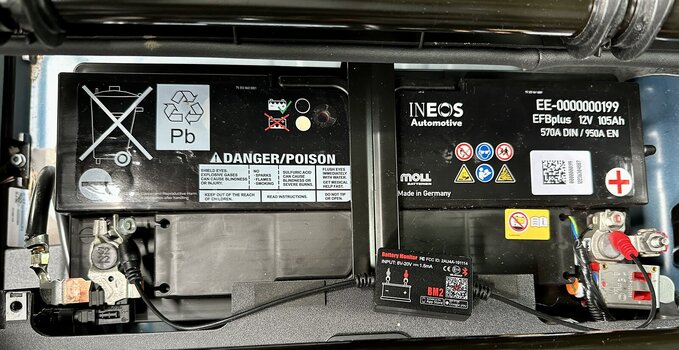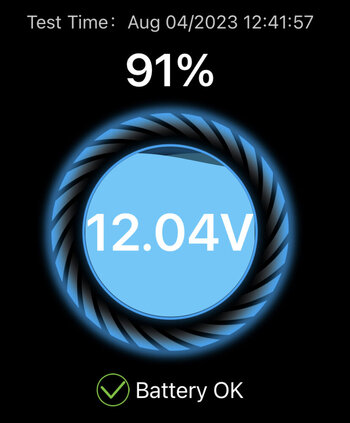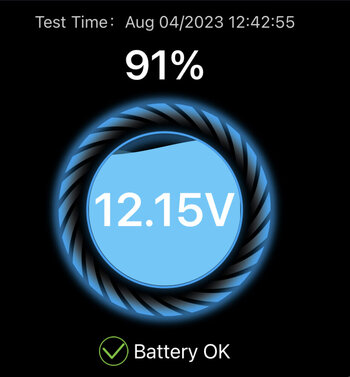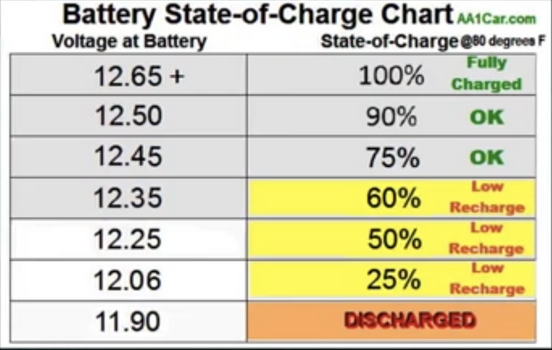The Grenadier Forum
Register a free account today to become a member! Once signed in, you'll be able to contribute to the community by adding your own topics, posts, and connect with other members through your own private inbox! INEOS Agents, Dealers or Commercial vendors please contact admin@theineosforum.com for a commercial account.
You are using an out of date browser. It may not display this or other websites correctly.
You should upgrade or use an alternative browser.
You should upgrade or use an alternative browser.
(The battery and monitor thread )Car dead in the middle of the woods
Sorry @Lollo050968 you misunderstood me or I wasn't clear. I was commenting on the actual numbers not why you have the monitors. I have one on my second battery now (not a grenadier).That you know, how the battery charging procedure work or not, and that we can tell Ineos that something have to be changed or change by ourselves, and important that noone else will have the experience of @das mo . I want to know before, that battery is down.
I was wondering firstly how the starter got down to 70% and the auxiliary to 30%, and secondly how the IA system showed 78%?
Upvote
0
OK! Yes 78% is the precisly Ineos Software….Monitor will show only starter battery…. 70 to 78% both systems will have tolerances
Upvote
0
I'd be happier if INEOS simply adapted their existing software to incorporate an extra SOC (state of charge) for any 2nd battery fitted - their seems to be plenty of room available.

Upvote
0
You need to spend AU$200-300 for a battery monitor that will accurately calculate SOC, anything else is just a rough guide. Ineos will be using a basic shunt somewhere off the starter battery so who knows how accurate it is.How does this make any sense?
Upvote
0
I doubt this is possible with the current setup.I'd be happier if INEOS simply adapted their existing software to incorporate an extra SOC (state of charge) for any 2nd battery fitted - their seems to be plenty of room available.
View attachment 7822255
Upvote
0
I'd be happier if INEOS simply adapted their existing software to incorporate an extra SOC (state of charge) for any 2nd battery fitted - their seems to be plenty of room available.
View attachment 7822255
When you say 'plenty of room' do you mean on the GUI (screen) or in the memory/code ?
What hardware is available to look at the state of the second battery ?
Upvote
0
Einen Batteriewaechter mit Kontrolle ueber eine App zu installieren macht Sinn, wenn man sicher sein will, wie der aktuelle Ladezustand der AUX Batterie ist.
Ich habe zur Zeit einen 1.5 kVA Wechselrichter (230V AC) an der AUX Batterie angeschlossen, um einen 600 Watt FM Broadcast Sender kurzfristig zu betreiben.
Nach ca. 30 min ist die AUX Batterie relativ leer gesaugt, es fliessen ca. 100 A auf der 12 Volt Ebene. Die Abschaltspannung ist im Wechselrichter-Monitoring auf 11.9 V eingestellt.
Nur mit dem Smart-Pass alleine braucht man ewig, um die AUX Batterie annaehernd auf 80% mit Motorbetrieb und der LiMa wieder aufzuladen.
Mit der Installation des D250 (DC/DC Charger) parallel zum Smartpass geht es entsprechend schneller.
Um wirklich sicher zu sein, wie voll geladen die AUX Batterie ist, kommt man nicht um ein Spannungsmonitoring (Batteriewaechter) direkt an der AUX Batterie herum.
Ich habe zur Zeit einen 1.5 kVA Wechselrichter (230V AC) an der AUX Batterie angeschlossen, um einen 600 Watt FM Broadcast Sender kurzfristig zu betreiben.
Nach ca. 30 min ist die AUX Batterie relativ leer gesaugt, es fliessen ca. 100 A auf der 12 Volt Ebene. Die Abschaltspannung ist im Wechselrichter-Monitoring auf 11.9 V eingestellt.
Nur mit dem Smart-Pass alleine braucht man ewig, um die AUX Batterie annaehernd auf 80% mit Motorbetrieb und der LiMa wieder aufzuladen.
Mit der Installation des D250 (DC/DC Charger) parallel zum Smartpass geht es entsprechend schneller.
Um wirklich sicher zu sein, wie voll geladen die AUX Batterie ist, kommt man nicht um ein Spannungsmonitoring (Batteriewaechter) direkt an der AUX Batterie herum.
Upvote
0
- Local time
- 7:26 AM
- Joined
- Jul 27, 2022
- Messages
- 6,005
I think it would need a second battery monitor on the auxiliary battery.I doubt this is possible with the current setup.
The battery monitor, I think, is this thing attached to the negative terminal of the main battery:
Upvote
0
I went for 2 BM2 that someone proposed here. Cant find the post, but thanks for comparing some of the cheaper monitor!@das mo which one did you install?

Did not want to put lots of money on it for now, but only observe overall behaviour of the 2 measures in comparison to the Ineos one.
Seems the initial measures after install yesterday been off. After another 24h without moving the car, Ineos load status dropped 4 points to 74% whilst both monitors report stable 90% ish.


Meeting dealer in one week and hope collect some insight on system behaviour till then.
Upvote
0
I'd charge the batteries first to float with a smart charger. You should be seeing this sort of correlation between voltage and state of charge when batteries are at rest, i.e, vehicle has sat overnight.Seems the initial measures after install yesterday been off. After another 24h without moving the car, Ineos load status dropped 4 points to 74% whilst both monitors report stable 90% ish
Attachments
Last edited:
Upvote
0
There is obviously some disparity between the voltage and the shunt, which leads me to suspect that whatever is draining the battery is not connected through the shunt.I went for 2 BM2 that someone proposed here. Cant find the post, but thanks for comparing some of the cheaper monitor!
View attachment 7822346
Did not want to put lots of money on it for now, but only observe overall behaviour of the 2 measures in comparison to the Ineos one.
Seems the initial measures after install yesterday been off. After another 24h without moving the car, Ineos load status dropped 4 points to 74% whilst both monitors report stable 90% ish.
View attachment 7822347
View attachment 7822348
Meeting dealer in one week and hope collect some insight on system behaviour till then.
Upvote
0
- Local time
- 7:26 AM
- Joined
- Jul 27, 2022
- Messages
- 6,005
Can you explain that some more, I'm not understanding.There is obviously some disparity between the voltage and the shunt, which leads me to suspect that whatever is draining the battery is not connected through the shunt.
Upvote
0
- Local time
- 7:26 AM
- Joined
- Jul 27, 2022
- Messages
- 6,005
There seems a huge disparity in what the actual voltage readings mean?I'd charge the batteries first to float with a smart charger. You should be seeing this sort of correlation between voltage and state of charge when batteries are at rest, i.e, vehicle has sat overnight.
The battery monitor reads 12.04v and interprets this as 91%, green, battery OK; but your lookup table (not dissimilar to others) would put that voltage at under 25%.
Am I seeing this right?
Upvote
0
The shunt reads the current going in and out of the battery, there may be loads not connected through the shunt so this is possibly why the voltage reads lower than the %Can you explain that some more, I'm not understanding.
Upvote
0
There is obviously some disparity between the voltage and the shunt, which leads me to suspect that whatever is draining the battery is not connected through the shunt.
I'd agree with that ... i'd expect a light load (a clock for example) but nothing too heavy ??
@das mo what do you see if the cars is disconnected from the battery (ie take the red + lead off) ?
Upvote
0
Morning.I'd agree with that ... i'd expect a light load (a clock for example) but nothing too heavy ??
@das mo what do you see if the cars is disconnected from the battery (ie take the red + lead off) ?
You say disconnecting car from both batteries and them keep observing the two battery monitors?
Upvote
0
- Local time
- 7:26 AM
- Joined
- Jul 27, 2022
- Messages
- 6,005
By the shunt do you mean the Ineos battery monitor connected to the negative terminal? If so how can loads bypass this, there's only the one connection on the terminal?The shunt reads the current going in and out of the battery, there may be loads not connected through the shunt so this is possibly why the voltage reads lower than the %
Isn't the % just a calculation/lookup table based on the voltage reading?
Upvote
0
Yes, the monitor. There may be other powered items that are earthed to the body so not using the common earth. Yes the % is a calculation but in the world of SLA batteries this is way off correct.By the shunt do you mean the Ineos battery monitor connected to the negative terminal? If so how can loads bypass this, there's only the one connection on the terminal?
Isn't the % just a calculation/lookup table based on the voltage reading?
Upvote
0
- Local time
- 7:26 AM
- Joined
- Jul 27, 2022
- Messages
- 6,005
So how are they completing the circuit back to the battery if not using this terminal?There may be other powered items that are earthed to the body so not using the common earth.
Upvote
0
Similar threads
- Replies
- 51
- Views
- 3K
- Replies
- 26
- Views
- 2K
- Replies
- 36
- Views
- 2K
- Replies
- 19
- Views
- 1K




